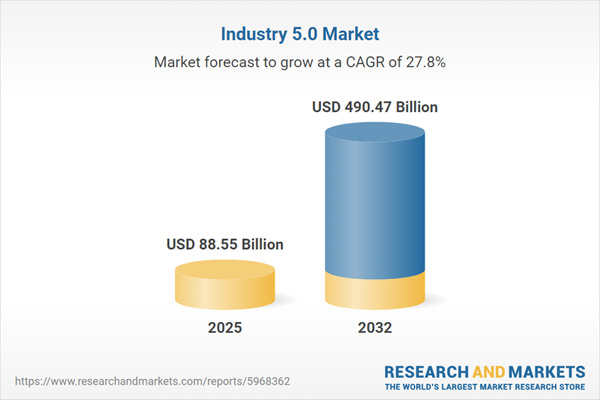Speak directly to the analyst to clarify any post sales queries you may have.
Industry 5.0 is advancing industrial transformation by combining advanced automation, artificial intelligence, and a skilled workforce to shape a human-centric manufacturing future. Senior decision-makers need clarity on technological convergence, evolving risks, and actionable strategies to stay competitive in this rapidly evolving environment.
Market Snapshot: Industry 5.0 Growth Trajectory
The Industry 5.0 market grew from USD 68.97 billion in 2024 to USD 88.55 billion in 2025. It is projected to expand further at a CAGR of 27.78%, reaching USD 490.47 billion by 2032.
Market growth is being driven by the seamless integration of AI, collaborative robotics, and digital infrastructure, making intelligent automation accessible across diverse sectors globally.Scope & Segmentation
This report provides a comprehensive breakdown of the Industry 5.0 landscape, focusing on five key segmentation dimensions to empower informed decisions:
- Technology: AI (including computer vision, machine learning, natural language processing); Cybersecurity (application, endpoint, and network security); Edge Computing (fog computing, micro data centers); IoT (AIoT, industrial IoT, sensor networks); Robotics (autonomous mobile robots, collaborative robotics, industrial robots)
- End User: Aerospace (commercial, defense, space); Automotive (aftermarket, OEM, tier 1 suppliers); Electronics (components, consumer electronics, semiconductors); Healthcare (hospitals, medical devices, pharmaceuticals, telemedicine); Manufacturing (automotive, electronics, food and beverage, pharmaceuticals)
- Application: Digital twin solutions (design optimization, real-time monitoring); Human-machine interaction (augmented reality interfaces, collaborative operation); Predictive maintenance (anomaly detection, condition monitoring); Quality control (statistical process control, visual inspection); Supply chain optimization (inventory management, logistics planning)
- Component: Hardware (actuators, controllers, platforms, sensors); Software (analytics software, integration software, security software); Services (consulting, integration, support)
- Deployment Mode: Cloud (private, public); Hybrid (edge hybrid, multi-cloud); On-premises (control room, factory floor)
The market is analyzed across regions, including:
- Americas: United States, Canada, Mexico, Brazil, Argentina, Chile, Colombia, Peru
- Europe, Middle East & Africa: United Kingdom, Germany, France, Russia, Italy, Spain, Netherlands, Sweden, Poland, Switzerland, United Arab Emirates, Saudi Arabia, Qatar, Turkey, Israel, South Africa, Nigeria, Egypt, Kenya
- Asia-Pacific: China, India, Japan, Australia, South Korea, Indonesia, Thailand, Malaysia, Singapore, Taiwan
Company analysis includes Siemens Aktiengesellschaft, Schneider Electric SE, ABB Ltd, Rockwell Automation, Inc., Honeywell International Inc., Emerson Electric Co., Mitsubishi Electric Corporation, FANUC Corporation, Yaskawa Electric Corporation, and KUKA Aktiengesellschaft.
Key Takeaways for Senior Decision-Makers
- Emphasizing the blend of intelligent machines and human expertise, Industry 5.0 enables adaptive manufacturing processes, stronger labor engagement, and improved operational resilience.
- Human-centric design and advanced robotics are opening avenues for flexible production lines, customized products, and advanced predictive maintenance—reshaping manufacturing competitiveness.
- As industry boundaries shift, organizations need new digital infrastructure models that support real-time decision-making, collaborative workflows, and agile supply chains.
- Elevated cybersecurity investments and the use of digital twins are turning risk management into a core competency, reducing vulnerabilities and downtime in highly connected environments.
- Consortia and cross-sector partnerships are accelerating the development and deployment of scalable, interoperable Industry 5.0 solutions, setting new standards for market growth.
Tariff Impact: Navigating the 2025 US Trade Landscape
The introduction of new US tariffs in 2025 has added both complexity and urgency to procurement and supply strategies for Industry 5.0 stakeholders. Increased duties on robotics modules, sensors, and computing platforms are prompting businesses to diversify sourcing, strengthen inventory management, and implement tariff engineering to safeguard profitability. Adaptation measures, such as nearshoring and regulatory-responsive compliance, are proving crucial for sustaining long-term supply chain resilience.
Methodology & Data Sources
This analysis draws on structured interviews with top executives and engineers, alongside secondary research from financial statements, regulatory filings, and technical briefs. Quantitative insights are validated through statistical modeling, while qualitative themes are synthesized from industry narratives, ensuring consistency and actionable relevance.
Why This Report Matters
- Enables executive teams to benchmark evolving technologies, workforce strategies, and compliance demands across global Industry 5.0 implementations.
- Delivers practical insights on financial planning, procurement strategy, and digital transformation—including the navigation of evolving tariff landscapes.
- Empowers stakeholders with clear market segmentations and regional analysis to support investment prioritization and partnership decisions.
Conclusion
Industry 5.0 is shaping a future defined by the synergy of technology and human potential. Decision-makers equipped with these insights will be positioned to accelerate innovation, mitigate risk, and achieve sustained operational excellence.
Additional Product Information:
- Purchase of this report includes 1 year online access with quarterly updates.
- This report can be updated on request. Please contact our Customer Experience team using the Ask a Question widget on our website.
Table of Contents
3. Executive Summary
4. Market Overview
7. Cumulative Impact of Artificial Intelligence 2025
Companies Mentioned
The companies profiled in this Industry 5.0 market report include:- Siemens Aktiengesellschaft
- Schneider Electric SE
- ABB Ltd
- Rockwell Automation, Inc.
- Honeywell International Inc.
- Emerson Electric Co.
- Mitsubishi Electric Corporation
- FANUC Corporation
- Yaskawa Electric Corporation
- KUKA Aktiengesellschaft
Table Information
| Report Attribute | Details |
|---|---|
| No. of Pages | 185 |
| Published | October 2025 |
| Forecast Period | 2025 - 2032 |
| Estimated Market Value ( USD | $ 88.55 Billion |
| Forecasted Market Value ( USD | $ 490.47 Billion |
| Compound Annual Growth Rate | 27.7% |
| Regions Covered | Global |
| No. of Companies Mentioned | 11 |









